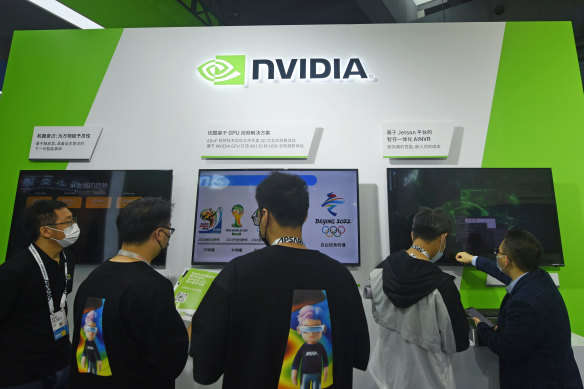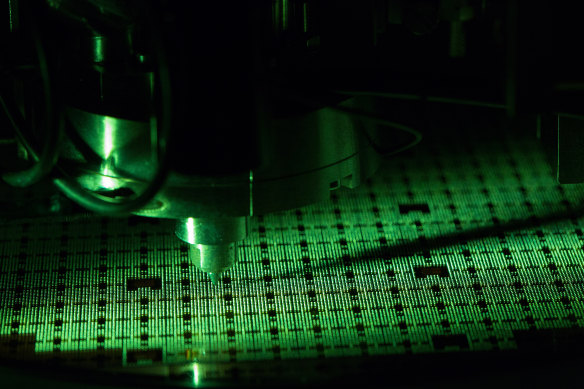
That’s despite China having spent more than $US100 billion of a planned $US150 billion under a state-directed program to fast-track development of its own semiconductor sector, a program that presumably isn’t quite going to plan given recent corruption investigations of many of the sector’s leaders.
China is the world’s biggest market for the chips but manufactures mainly the less advanced chips it needs for its consumer goods manufacturers. It relies on imports from Taiwan, South Korea and the US for the more advanced chips.
Those new generation chips are fundamental for the artificial intelligence that will be increasingly critical to 21st century technologies, including military technologies.

Nvidia disclosed that the US government had imposed export restrictions on two of its most advanced chips, barring the company from exporting them to China or Hong Kong.Credit:AP
The US effort to slow the rate of China’s technological progress goes beyond the investment in domestic manufacturing and R&D and bans on exports by US manufacturers.
The semiconductor industry is a complex global ecosystem. The US dominates design of advanced chips and the equipment that manufactures and the intellectual property that supports them but the manufacturing is dominated by Taiwan. South Korea is also a major manufacturer and Japan a major supplier of equipment and materials to the sector.
In terms of the machinery for manufacturing the leading-edge chips, Dutch-based ASML is the only supplier of the massive $US150 million machines that can produce the most advanced semiconductors in volume. Under pressure from the US, while ASML sells some of its older systems to China, it hasn’t exported its latest generation machines there since 2019.
China has been making some progress in its development of its own capabilities but is still years behind where the bleeding edge of the Chip 4 group’s technologies have reached.
The CHIPS Act specifically prohibits companies that receive US funding from increasing their production of chips in China, which will affect Taiwan’s Taiwan Semiconductor Manufacturing Company (TSMC) and South Korea’s Samsung, both of which have US plants under construction and both of which are major suppliers to China.
It’s not that funding that is the most powerful coercive tool in the US armoury. Taiwan and South Korea rely on – and almost completely dependent on – America’s chip designers and equipment makers to produce the advanced chips that the US is focused on.
China might be their biggest market and they all have manufacturing facilities within China but the US dominance of the technology means they would have nothing to sell if they ran foul of the US, whereas China has no realistic alternative at present but to buy from them.
The mutual dependence of the US, Taiwan, South Korea and Japan at the core of the production of advanced chips has led to the formation of a US-led alliance, the so-called “Chip 4”, as a forum for discussing sectoral issues.
The US ambition is obvious. Apart from resolving some of the industry bottlenecks exposed by the pandemic – there are still shortages of semiconductors that affect everything from automobiles production to consumer electronics – the US will want to use Chip 4 to restrict or deny China access to the most advanced chips.

The US dominates the design of advanced chips and the equipment that manufactures and the intellectual property that supports them but the actual manufacturing is dominated by Taiwan.Credit:Bloomberg
China has been making progress in development of its own capabilities but is still years behind where the bleeding edge of the Chip 4 group’s technologies have reached. The US is trying to maintain and extend that capability gap and the impact it will have on limiting China’s broader technology and military ambitions.
The CHIPs Act isn’t going to turn the US into a powerhouse of chipmaking – it would take trillions of dollars of subsidies and decades to do that – but is a step towards reducing its reliance on Taiwan-based manufacturing, where the threat from China has escalated.
Loading
It’s another a brick in the wall it is trying to build, it hopes in conjunction with its Chip 4 allies, around China’s access to the most strategic element of 21st Century technologies and another intense friction point in its increasingly fractious relationship with China.
The Business Briefing newsletter delivers major stories, exclusive coverage and expert opinion. Sign up to get it every weekday morning.









 Add Category
Add Category